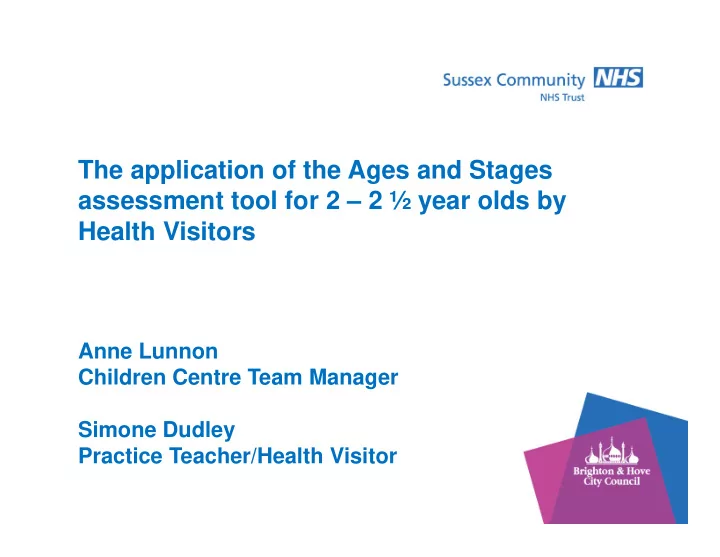

The application of the Ages and Stages assessment tool for 2 – 2 ½ year olds by Health Visitors Anne Lunnon Children Centre Team Manager Simone Dudley Practice Teacher/Health Visitor
The Healthy Child Programme two year review • All children are offered a two year review • National assessment tool is the Ages and Stages questionnaire, 3 rd edition, British English version • April 2015 reporting on how many two year reviews have been completed using a ASQ-3 questionnaire • • From October 2015 fuller data will be submitted to the Children and Young People’s Health Services (CYPHS) dataset • DOH is developing an outcome measure of child development across England
The ASQ-3 assessment tool • Parents assess their child’s development, highlight key milestones, enhance their sensitivity to their child’s development and help them to identify ‘trouble spots’ early. • Validated assessment tool that has been extensively tested – based on child development norms in USA covering 15,000 children • The local decision has been made to complete the 27 months version with all families. The window for completing this with an individual child is between 25 months 16 days through to 28 months 15 days • On occasion it may be necessary to complete the 30 months version when a child has exceeded the above time frame
ASQ-3 questionnaire Measures 5 areas of interest separately: (1) communication (2) gross motor (3) fine motor (4) problem solving (5) personal-social
Scoring areas of interest • 6 questions in each area of interest - possible answers : yes, sometimes, not yet • Activities the child has not been able to try are left blank • 1 or 2 items in section untried/missing, total area score is adjusted, child is not penalised for activities not had the opportunity to try • >2 items are missing the area should not be scored and the section reviewed • A total score for each area is transferred to information summary • Overall section with space for additional comments which takes in to account parents’ concerns
Interpretation – Information summary sheet • Cut off scores – what is appropriate development • HV transfers the total score for each area of interest and fills in the corresponding circles • If the child’s total score is in the white area, it is above the cut off, the child’s development appears to be on schedule • If the child’s total score is in the grey area, it is close to the cut off and requires monitoring and providing learning activities • If the child’s total score is in the black area, it is below the cut off and requires further assessment, referral to specialist services
Universal Health Visiting Service • At 26 months appt made with the parent and asked to complete the ASQ-3, 27 month questionnaire • If the child is older than 28 months and 15 days ASQ-3, 30 months questionnaire is used • At appt with HV, ASQ-3 discussed and completed • Information summary sheet completed and filed in HV records • ASQ-3 questionnaire returned to parent to keep • HV completes the 2 year Family Health Review with parent • HV completes PCHR (red book, notes section)
What happens next • Any actions from the Review are discussed and agreed with parent and documented in HV records • HV considers offering UP/UPP service if additional needs for the child/family are identified • If the child has identified SEND HV agrees with parents whether they wish to complete the ASQ-3 with their child • If the child is in a EY setting a copy of the 27 month ASQ-3 information summary will be sent to the EY setting from Sept 2015
Targeted Health Visiting service • HV makes an appointment with the parent at either home/local children centre • Where parents prefer or find it necessary completion of the ASQ-3 questionnaire will be made by the HV • The Universal Plus or Universal Partnership Plus Action Plan will be updated and any required liaison with EY settings made • If the child is in a EY setting a copy of the 27 month ASQ-3 information summary will be sent to the EY setting from Sept 2015
Conclusion • ASQ-3 is part of an overall review of a child’s development • ASQ-3 questionnaire encourages partnership working, puts the parent in control and helps the parent to understand their child’s development • ASQ-3 prepares parents for the next stage in their child’s development • We welcome the opportunity to receive copies of the EYFS Progress Check at Two from the EY settings
Recommend
More recommend